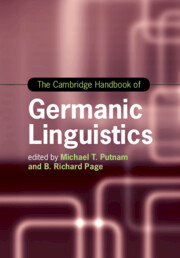Book contents
- The Cambridge Handbook of Germanic Linguistics
- Cambridge Handbooks in Language and Linguistics
- The Cambridge Handbook of Germanic Linguistics
- Copyright page
- Contents
- Figures
- Maps
- Tables
- Contributors
- Acknowledgments
- Germanic Languages
- Part I Phonology
- Part II Morphology and Agreement Systems
- Part III Syntax
- Part IV Semantics and Pragmatics
- Part V Language Contact and Nonstandard Varieties
- Index
- References
Germanic Languages
An Overview
Published online by Cambridge University Press: 31 March 2020
- The Cambridge Handbook of Germanic Linguistics
- Cambridge Handbooks in Language and Linguistics
- The Cambridge Handbook of Germanic Linguistics
- Copyright page
- Contents
- Figures
- Maps
- Tables
- Contributors
- Acknowledgments
- Germanic Languages
- Part I Phonology
- Part II Morphology and Agreement Systems
- Part III Syntax
- Part IV Semantics and Pragmatics
- Part V Language Contact and Nonstandard Varieties
- Index
- References
Summary
The Germanic languages include some of the world’s most widely spoken and thoroughly researched languages. English has become a global language that serves as a lingua franca in many parts of the world and has an estimated 1.12 billon speakers (Simons and Fennig 2018). German, Dutch, Icelandic, Swedish, and Norwegian have also been studied and described extensively from both diachronic and synchronic perspectives. In addition to the standard varieties of these languages, there are available descriptions of many nonstandard varieties as well as of regional and minority languages, such as Frisian and Low German. There are several possibilities to consider when putting together a handbook of a language family. One would be to have a chapter devoted to each language, as in König and Auwera (1993).
- Type
- Chapter
- Information
- The Cambridge Handbook of Germanic Linguistics , pp. 1 - 8Publisher: Cambridge University PressPrint publication year: 2020
References
- 1
- Cited by

